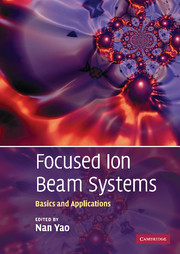Book contents
- Frontmatter
- Contents
- List of contributors
- Preface
- 1 Introduction to the focused ion beam system
- 2 Interaction of ions with matter
- 3 Gas assisted ion beam etching and deposition
- 4 Imaging using electrons and ion beams
- 5 Characterization methods using FIB/SEM DualBeam instrumentation
- 6 High-density FIB-SEM 3D nanotomography: with applications of real-time imaging during FIB milling
- 7 Fabrication of nanoscale structures using ion beams
- 8 Preparation for physico-chemical analysis
- 9 In-situ sample manipulation and imaging
- 10 Micro-machining and mask repair
- 11 Three-dimensional visualization of nanostructured materials using focused ion beam tomography
- 12 Ion beam implantation of surface layers
- 13 Applications for biological materials
- 14 Focused ion beam systems as a multifunctional tool for nanotechnology
- Index
- References
7 - Fabrication of nanoscale structures using ion beams
Published online by Cambridge University Press: 12 January 2010
- Frontmatter
- Contents
- List of contributors
- Preface
- 1 Introduction to the focused ion beam system
- 2 Interaction of ions with matter
- 3 Gas assisted ion beam etching and deposition
- 4 Imaging using electrons and ion beams
- 5 Characterization methods using FIB/SEM DualBeam instrumentation
- 6 High-density FIB-SEM 3D nanotomography: with applications of real-time imaging during FIB milling
- 7 Fabrication of nanoscale structures using ion beams
- 8 Preparation for physico-chemical analysis
- 9 In-situ sample manipulation and imaging
- 10 Micro-machining and mask repair
- 11 Three-dimensional visualization of nanostructured materials using focused ion beam tomography
- 12 Ion beam implantation of surface layers
- 13 Applications for biological materials
- 14 Focused ion beam systems as a multifunctional tool for nanotechnology
- Index
- References
Summary
Introduction
Nano-fabrication aims at building nanoscale structures, which can be used as components, devices, or systems, in large quantities with potentially low costs. Here, a nanoscale structure is characterized by a feature size in the range of 0.1 to 100 nm. Recently, ion beams have become increasingly popular tools for the fabrication of various types of nanoscale structures for different applications. In this chapter, the capabilities of the ion beam (IB) technology for nano-fabrication using the projection printing and direct writing approaches are discussed and examined.
The IB technology has many advantages over other energetic particle beams in nano-fabrication. For example, when compared to electrons, ions are much heavier and can strike with much greater energy density on the target at relatively short wavelengths to directly transfer patterns on hard materials (such as semiconductors, metals, or ceramics) without producing forward- and backscattering. Thus, the feature size of the patterns is directly dictated by the beam size and the interaction of the beam with the material considered. On the other hand, the electron beam or photon beam can only effectively write on or expose soft materials (such as photo or e-beam resists), and the corresponding feature sizes are determined by the proximity of the backscattered electrons or wave diffraction limits. Furthermore, the lateral exposure in IB is very low; thus, just exposing the right areas.
Information
- Type
- Chapter
- Information
- Focused Ion Beam SystemsBasics and Applications, pp. 187 - 214Publisher: Cambridge University PressPrint publication year: 2007
References
Accessibility standard: Unknown
Why this information is here
This section outlines the accessibility features of this content - including support for screen readers, full keyboard navigation and high-contrast display options. This may not be relevant for you.Accessibility Information
- 1
- Cited by
